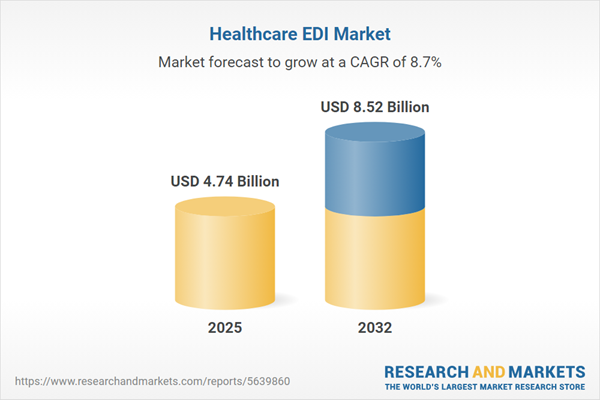Speak directly to the analyst to clarify any post sales queries you may have.
The healthcare EDI market is experiencing strong momentum, shaped by regulatory complexity and the drive for operational efficiency. Senior leaders recognize a critical need for agile, secure, and interoperable solutions as digital transformation and value-based care strategies advance in both mature and emerging healthcare landscapes.
Market Snapshot: Healthcare EDI Market Growth Trajectory
The Healthcare EDI Market grew from USD 4.38 billion in 2024 to USD 4.74 billion in 2025. It is expected to continue growing at a CAGR of 8.65%, reaching USD 8.52 billion by 2032.
Comprehensive Scope & Segmentation
- Component: Services (Consulting Services, Implementation Services, Support Services), Solutions (EDI Software, Integration Platform)
- Function: Claims Management (Claim Payments, Claim Status, Claims Submission, Eligibility Verification, Payment Remittance, Referral Certification & Authorization), Healthcare Supply Chain
- Process Type: Direct EDI/Point-to-Point, EDI via AS2, Value-Added Network, Web EDI
- Deployment: On-Cloud, On-Premise
- End-User: Healthcare Payers, Healthcare Providers, Medical Device & Pharmaceutical Industries, Pharmacies
- Region: Americas (United States, Canada, Mexico, Brazil, Argentina, Chile, Colombia, Peru), Europe, Middle East & Africa (United Kingdom, Germany, France, Russia, Italy, Spain, Netherlands, Sweden, Poland, Switzerland, United Arab Emirates, Saudi Arabia, Qatar, Turkey, Israel, South Africa, Nigeria, Egypt, Kenya), Asia-Pacific (China, India, Japan, Australia, South Korea, Indonesia, Thailand, Malaysia, Singapore, Taiwan)
- Companies Covered: Accenture plc, Apex EDI, Inc. by The Therapy Brands, Athenahealth, Inc., AUTOCRUITMENT LLC, Availity, LLC, Change Healthcare, Cognizant Technology Solutions Corporation, Comarch SA, Connvertex Technologies Inc., Cprime, Inc., GE Healthcare, McKesson Corporation, Medisys Inc., NXGN Management, LLC by Planet DDS, Inc., Optum, Inc. by UnitedHealth Group Inc, Oracle Corporation, OSP Labs, PLEXIS Healthcare Systems, Inc., Quadax, Inc., Remedi Electronic Commerce Group, Salesforce, Inc., SPS Commerce, Inc., SSI Group, LLC, Tebra Technologies, Inc., Veradigm LLC
Key Takeaways: Strategic Insights for Senior Leaders
- Digital transformation continues to reshape the healthcare EDI market, driving the replacement of legacy systems with integrated, API-enabled platforms and cloud-based deployments that improve information sharing and workflow transparency.
- Regulatory harmonization and increased data privacy requirements heighten the need for robust compliance features. Vendors are embedding security and audit functions into EDI solutions to address these mandates.
- Healthcare organizations prioritize interoperability and automation, leveraging AI and analytics to streamline administrative functions including claims management and eligibility verification.
- Adoption of cloud-native architectures enables greater scalability and cost predictability, giving payers and providers flexibility in adapting to evolving business and technology requirements.
- The regional landscape reveals varying maturity levels, with North America and Western Europe advancing through sophisticated analytics and regulatory alignment, while Asia-Pacific and emerging EMEA markets rapidly expand digital infrastructure and mobile integrations.
- Strategic partnerships between EDI technology vendors, cloud service providers, and managed services specialists enable bundled solutions that support comprehensive data exchange, user experience improvements, and faster partner onboarding.
Tariff Impact on Market Dynamics
Recent tariff increases in the United States on imported EDI hardware and software components have altered cost structures across the healthcare EDI ecosystem. Vendors are reassessing sourcing strategies and supply chains to mitigate additional costs, spurring a shift towards cloud-based and virtualized integration environments. Organizations are also renegotiating vendor contracts, seeking agile solutions that help manage financial exposure and ensure ongoing data exchange regardless of import volatility.
Methodology & Data Sources
This report integrates primary and secondary research to ensure accuracy and reliability. The methodology combines extensive desk analysis of regulatory and technology trends, interviews with industry executives and EDI specialists, and robust data triangulation with sector benchmarks and anonymized platform usage patterns for validation.
Why This Report Matters
- Enables leaders to make informed strategic decisions on healthcare EDI adoption, technology roadmaps, and compliance management.
- Provides actionable intelligence on vendor capabilities, deployment models, and regional dynamics for competitive advantage.
- Highlights best practices for navigating regulatory shifts, technology disruptions, and cost pressures.
Conclusion
The future of healthcare electronic data interchange lies in adopting flexible, cloud-native, and interoperable platforms that align with organizational and regulatory objectives. Proactive investment and collaboration are essential for sustaining performance and optimizing outcomes across this evolving landscape.
Additional Product Information:
- Purchase of this report includes 1 year online access with quarterly updates.
- This report can be updated on request. Please contact our Customer Experience team using the Ask a Question widget on our website.
Table of Contents
3. Executive Summary
4. Market Overview
7. Cumulative Impact of Artificial Intelligence 2025
Companies Mentioned
The companies profiled in this Healthcare EDI market report include:- Accenture plc
- Apex EDI, Inc. by The Therapy Brands
- Athenahealth, Inc.
- AUTOCRUITMENT LLC
- Availity, LLC
- Change Healthcare
- Cognizant Technology Solutions Corporation
- Comarch SA
- Connvertex Technologies Inc.
- Cprime, Inc.
- GE Healthcare
- McKesson Corporation
- Medisys Inc.
- NXGN Management, LLC by Planet DDS, Inc.
- Optum, Inc. by UnitedHealth Group Inc
- Oracle Corporation
- OSP Labs
- PLEXIS Healthcare Systems, Inc.
- Quadax, Inc.
- Remedi Electronic Commerce Group
- Salesforce, Inc.
- SPS Commerce, Inc.
- SSI Group, LLC
- Tebra Technologies, Inc.
- Veradigm LLC
Table Information
| Report Attribute | Details |
|---|---|
| No. of Pages | 185 |
| Published | November 2025 |
| Forecast Period | 2025 - 2032 |
| Estimated Market Value ( USD | $ 4.74 Billion |
| Forecasted Market Value ( USD | $ 8.52 Billion |
| Compound Annual Growth Rate | 8.6% |
| Regions Covered | Global |
| No. of Companies Mentioned | 26 |









